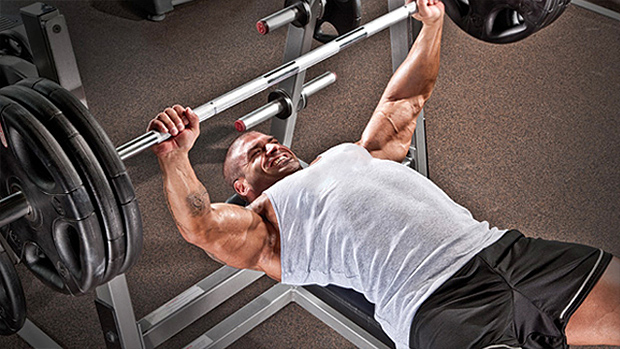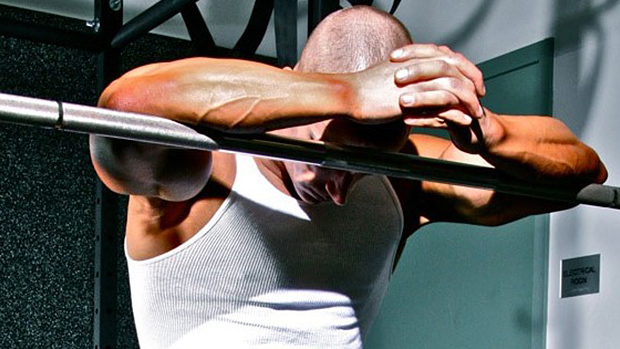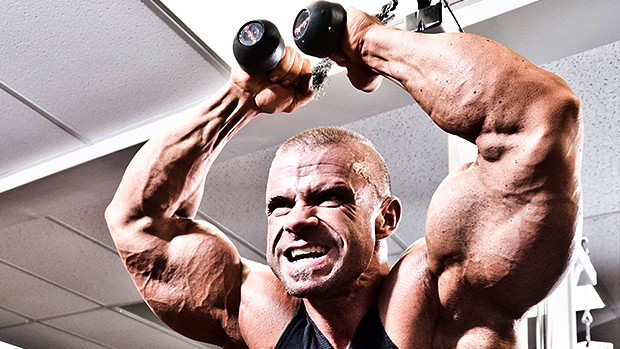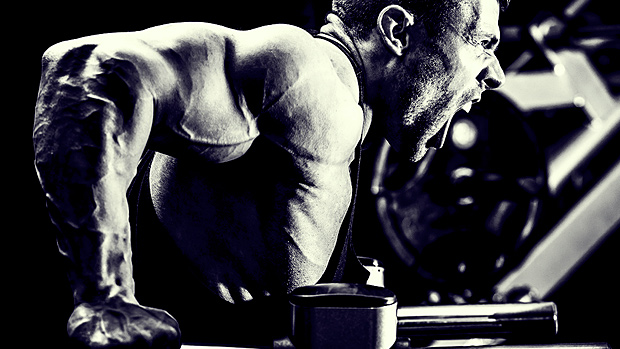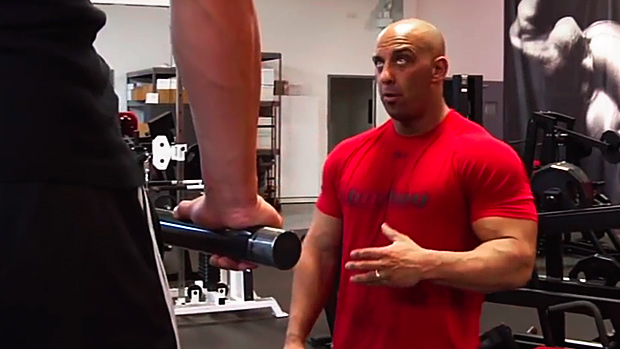Here's what you need to know...
- Leg Drive is the Secret. With proper timing and foot position, leg drive will help you bench more weight safely.
- Set Your Feet Early. At the start of setup, pull your feet back under your hips and dig the balls of your feet into the floor.
- Choose the Best Foot Position. Choose either toes down/heels up with legs tucked tightly to the bench, or heels flat with feet out wide.
- Choose the Right Cues. This will depend on whether you're a "stomper" or a "spreader."
- Drive Yourself Back Toward Your Head. Leg drive must initiate force backward toward the bar, not up toward the ceiling.
- Timing is Crucial. Practicing paused reps is hands-down the best way to synch up your press and leg drive.

Lifters talk about bench press leg drive like it's some mythical creature. They swear it exists but they've never been able to capture it. And if they could capture it, they'd finally be able to bench as much as they did back during high school football.
Then there are those who think they know how to use leg drive, only to have their ass fly a foot off the bench with every rep. Butt-lifting is a tough habit to break and powerlifters who compete must avoid it at all costs.
Leg drive doesn't have to be so complicated. It's just a matter of timing and using the proper cues based on your foot position. And, of course, lots of practice.
Most elite bench pressers dig their feet in early during the setup. Rather than leaving the positioning of their feet as an afterthought, they establish a solid foot position early and use that firm connection to the ground to leverage themselves into a tight setup.
This means getting your feet pulled back under your hips and using the balls of your feet to dig into the floor. Once your feet are planted, arch your body around your feet by continually driving into the floor and pulling your shoulders toward your hips.
You'll always get a tighter arch with your feet dug in than with your feet "soft," so get your feet planted early and use the ground to your advantage.
If you start with your feet up on the bench and pull yourself into an arch using the bar, make sure you drop your feet straight down or behind you to get a better starting position. Dropping your feet out in front of you will ultimately limit the tightness and leg drive you can achieve.
Foot position is arguably the most important factor for both leg drive and keeping your butt on the bench. When observing truly great benchers, you'll notice they often take one of two foot-positions:
Toes down/heels up with legs tucked tightly to the bench:

Heels flat with feet out wide:

Either foot position works to prevent butt-lifting while maintaining a firm setup and powerful leg drive, but choosing which one works best for you depends on a few factors.
Shorter lifters will have more success with heels up and legs tucked, while taller lifters do best with heels flat and feet out. This is simply because lifters come in all shapes and sizes while competition benches don't. Nearly all benches are 18 inches high, but if your femurs are 20 inches long, good luck getting your feet tucked behind you without shredding a hip flexor!
Be aware, however, that there is such a thing as having your feet too far back. Aim to get your heels under your hips. This will focus your leg drive on sending the bar backward, not just up. If your feet are further back, your femurs will be too vertical and any leg drive will send your butt rocketing off the bench.
Once you've considered limb length, account for which position allows you to apply the most force to the ground without lifting your butt off the bench.
At first glance, feet flat may seem best for force production because you have more surface area touching the floor. This is all well and good according to your physics textbook, but unless your brain can process which direction to apply the force, you may be out of luck.
How you actually execute your leg drive depends on your foot position. What works in one foot position won't work well in the other, so choose accordingly. Essentially, you're either a "stomper" or a "spreader," depending on whether your feet are hooked back or out wide, respectively.
With your heels up and feet hooked underneath your hips, leg drive boils down to one simple cue: stomp your heels to the floor. Then, as you lower the bar to your chest, squeeze your glutes tight and keep your feet as still as possible.
Once you're ready to press back up, squeeze the bench with your thighs (this will help maintain your arch and keep your butt on the bench) and slam your heels to the floor as hard as possible.
The process is slightly more complicated if your feet are flat and out wide. Rather than simply pressing downward into the floor (which lifts your hips up and off the bench), you must spread the floor outward as you lower the bar – much like a squat – and drive your toes into the front of your shoes as you press up.
Imagine doing a leg extension (don't worry, there's no shame in doing an imaginary leg extension) while keeping your feet flat and continuing to spread the floor. This extends your hips without further extending your lumbar spine, which is the real culprit in causing your butt to lift.

Proper leg drive must initiate force backward toward the bar, not up toward the ceiling. This keeps your butt on the bench while applying force toward the bar, nicely complementing the desired J-curve bar path that naturally places the bar over the appropriate joints for each phase of the lift.
Leg drive goes hand in hand (hand in foot?) with bar path. It's an urban legend that a straight line is the best bar path during the bench press. Sure, it's the shortest distance to lockout, but it's not the most efficient.
Pressing straight up with overly-tucked elbows will cause stalling off the chest because the bar never travels over the proper muscle groups for each phase of the lift. Instead, flaring the elbows halfway up will keep your elbows under the bar and send the bar back toward the face, allowing the chest and shoulders to assist the triceps.
Good leg drive accelerates the bar through the most common sticking point, which is a few inches off the chest. If you can blast through the point, it becomes much easier to flare the elbows and get the bar aligned over the triceps and shoulders. Also, the risk of your butt leaving the bench goes up exponentially if your bar path is straight up toward the ceiling and your leg drive is straight through the floor.
Ever see a lifter miss a bench press a few inches off the chest? The charade is predictable: The bar stalls and the lifter keeps pressing straight up. Once panic sets in, the lifter drives harder with the legs and the butt loses contact with the bench.
All this effort is admirable, but it's simply in the wrong direction. Driving backward – not upward – is the key to shattering your sticking point without your butt leaving the bench.

All these techniques are well and good, but they'll all be for nothing if you implement your leg drive at the wrong time. More often than not, lifters try to drive too early, and as many men know, losing it too early is frustrating and embarrassing.
It just takes practice to synch up the actions of your upper and lower body. Once you get it, you'll get exceptional power off the chest to blow through to lockout. Here's how:
- First, don't lift your hips up to meet the bar as you lower it. Far too often, lifters "hump" their hips to meet the bar on touch-and-go reps, which does nothing for leg drive because it's performed too early. Instead, lift your chest and lats while leaving your hips down. Try to spread your chest up to the bar, and use the appropriate leg action based on your foot position to keep your butt glued to the bench.
- Next, don't be too gentle when touching the bar to your chest. Many lifters bring the bar down so slowly and touch the chest so lightly that they get a poor stretch reflex, making it hard to reverse the bar regardless of powerful leg drive. Don't be afraid to let the bar sink in a bit and settle into the chest. Just don't lose your back tightness. This is where the "lats up" cue comes into play again.
- Finally, practice paused reps to master properly-timed leg drive. Powerlifters need to pause in competition anyway, so you might as well practice like you play.
Pull the bar down like a barbell row, stay tight as you pause on your chest, and throw the bar back up by pressing with your arms and driving with your legs at the same time.
Press with your arms too early and you risk getting stuck just off the chest. Drive with your legs too early and you'll dump the bar back toward your face without clearing the sticking point.
Use exaggerated pauses (3 to 5 seconds) during your warm-up sets to get a feel for your timing and reduce the pause for your heavy working sets.

